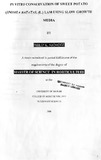| dc.description.abstract | An in vitro protocol was developed for short-term conservation of sweet potato by
modification of medium osmotic potential through incorporation of growth retardants
namely abscisic acid (ABA), mannitol, sorbitol and glyphosate (commercial Round
up). Single node cuttings from virus tested sweet potato genotypes were obtained
from the Plant Quarantine Station, Kenya. These materials were multiplied in vitro
on MS basal medium supplemented with 30g/1sucrose, 0.1g/l inositol, 0.1 g/l calcium
pantothenate, 0.1 g/l l-arginine, 0.02 g/l putrescine- HCL, 0.1 g/l calcium nitrate and
0.4 mg/l thiamine-HCl. The media was gelled with 2.5 mg/l phytagel. This
multiplication medium was used to multiply plants for conservation studies.
Single node cutting were cultured on slow growth medium as follows; In one
experiment five sweet potato genotypes: NC-1582, IRA-048, CPT 560, Lohafinjo and
KSP-20 were cultured designated as SW1to SW7. The medium: SW2, SW3, SW4,
SW5, SW6 ffi1,9 SW7 contained 4% mannitol, 6% mannitol, 2% sorbitol and 2%
mannitol combined and ABA at 0.5, 1.0, and 2.0 mg/l), respectively while the control
(SW1) contained no growth retardant. Single node cuttings of sweet potato genotypes
NC-1582 (440094), IRA-048 (440143), CPT560, Lohafinjo (440391) and KSP-20
were inoculated on the medium. A total of three hundred and fifty cultures were made
(5 genotypes x 7 treatments x 10 replications).
In second experiment two genotypes namely: Nyaluolo (local) and lITA-TIS-3290
(440068) and three medium treatments namely: SGl, SG2 and SG3 were utilised.
SG1 did not contain any glyphosate (control), whereas SG2 contained 5 mg/l
glyphosate, and SG3 contained 10mg/l glyphosate. All the tissue culture media were
autoc1aved at a temperature of 121°C and a pressure of 15 pounds per square inch
(p.s.i.) for 15 minutes. The plants were assessed on height on a monthly basis up to
five months. The number of roots, leaves and nodes, % leaf abscission and
percentage survival were scored at 2, 5 and 8 months respectively.
Analysis of variance (ANOVA) for height indicated significant differences for
genotypes, growth retardants and their interactions. However four treatments (4 %
mannitol, 6% mannitol, 1.0 mg/l ABA and 2.0 mg/l ABA) were the best slow growth
recipes. However treatments of mannitol significantly (p = 0.05) reduced % survival
compared to the control, and the best ABA treatments. Percentage survival was 65%
(control), 51.49 % (4% mannitol), 47.73 % (6 % mannitol), 74.8% (1.0 mgll of ABA)
and 80.5 for (2.0 mg/l of ABA). Mannitol also significantly (p = 0.05) reduced
internode lengths, leaf sizes and root means of five sweet potato genotypes.
The treatment combining sorbitol and mannitol (2% of each on w/w basis) was unable
to significantly retard growth of sweet potato genotypes, IRA-048 and NC-1582.
Plants significantly (p =0.05) outgrew the control after one month and four months for
the two genotypes, respectively. However the treatment was significantly superior to
the control in conservation of three genotypes namely: CPT- 560, KSP-20 and
Lohafinjo, throughout the study period.
Overall, ABA at concentration of 1-2 mgl" was the best retardant for the five
genotypes studied due to conservation of genotypic integrity, high percent survival,
minimal effect on photosynthetic surface and effective plant height retardation.
In the second experiment glyphosate was studied for in vitro conservation at 0 mg/l, 5
mg/l and 10 mg/l to conserve two sweet potato genotypes: Nyaluolo and
IITA- TIS-3290. Glyphosate treatments significantly (p = 0.05) retarded plant growth
throughout the 5 months of in-vitro culture. The two levels did not significantly
(p = 0.05) differ from one another. In addition, the two treatments completely
inhibited root formation in both genotypes. Mean survival was also significantly (p =
0.05) reduced by glyphosate. | en |

